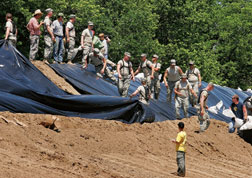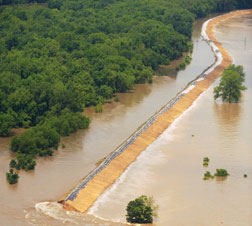While the flood fight and cleanup continues in the upper Midwest, national experts are pointing to the disaster as yet another gloomy warning that the nation’s infrastructure is sorely in need of some serious upgrades. “Katrina, I-35 and now these levees are examplesof how, when infrastructure is not accurately designed and maintained, it can result in the kind of catastrophe we are seeing now,” says David Mongan, president of the American Society of Civil Engineers. “We need to examine risk of failure in a very different way than we have in the past,” he adds. “We need to identify risk more effectively to the public, governments, legislators and public- works officials, so when they make a decision to fund or not to fund they understand the consequences.”
 AP/Wideworld Illinois National Guard troops on sandbagging detail reinforce Mississippi River levee.
|
From southern Wisconsin to Missouri, taxpayers and infrastructure owners are doing the math. By June 23, unusually high water on the Mississippi River and its tributaries had overtopped 32 levees. Of those, 26 were agricultural levees, meaning they are designed, built and operated by non-federal agencies. Six others were federal levees. One of those and several non-federal levees breached. The resulting floods from overtopping and breaches flooded thousands of homes and businesses and millions of acres of farmland. Highways and rail lines were cut, especially in Iowa, where, in two cases, railroad bridges were swept away.
Brig. Gen. Michael Walsh, commander of the U. S. Army Corps of Engineers Mississippi Valley Division and president designee of the Mississippi River Commission, pointed out that the overtopped levees do not represent performance failures: “It’s just that the design criteria have been exceeded,” he says.
Many of the agricultural levees are designed for 15- to 30-year storm levels and actually performed “well above their design,” says Alan Dooley, public affairs officer with the Corps’ St. Louis District. “In the Cedar Rapids area, we are thinking it was a 500-year-storm event,” says Walsh. “The water was 11 ft above the top of the levee’s elevation.”
By June 23, the Corps’ support of local levee districts included distribution of 1.3 million sandbags, almost 100 pumps, more than 400 rolls of plastic sheeting for reinforcing levees and the dispatch of more than 100 flood engineers to give technical advice. “We are providing technical assistance or guidance on request,” Walsh says. In addition to support with levees, the Corps also consulted with officials in Clarksville and Quincy, Ill., on ways to protect their water- and wastewater-treatment plants, Walsh adds.
 BY AP/Wideworld Mississippi River pours through break in levee north of Quincy, Ill., on June 18.
|
The Corps is diverting funds to support the emergency work, Walsh says. One project whose funding is being “reprioritized” is $35 million worth of dredging in New Orleans for cleanup of the results of heavy Mississippi flooding in April.
Most of the levees that overtopped and breached in record floods 15 years ago also were agricultural levees, Walsh says. Those levees and others were rebuilt using emergency procedures and funding available at the time, Walsh says. Subsequent upgrades to both agricultural and federal levees under the Water Resources Development Act and the “normal funding process” include the addition of relief wells and drainage areas. However, in this flood, even federal levees were showing stress, including sand boils and other signs of seepage.
On June 22, the Corps’ St. Louis District scrambled for emergency repairs when a hole opened on the river side of a gravity drain in the Prairie du Rocher levee district in Illinois. A Corps vessel conducted a sonar survey and found the problem was...



Post a comment to this article
Report Abusive Comment